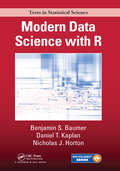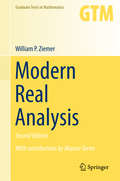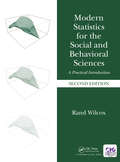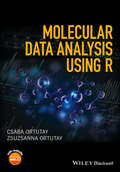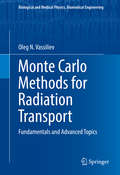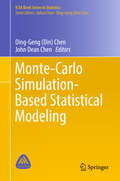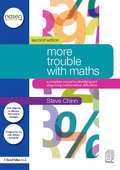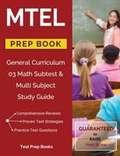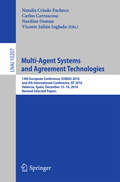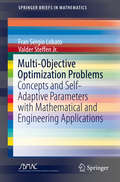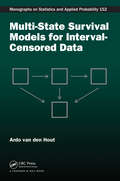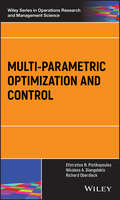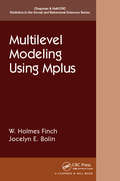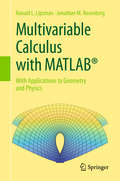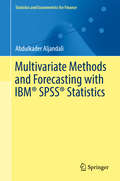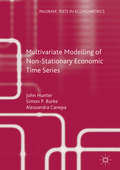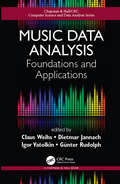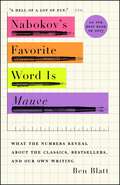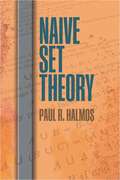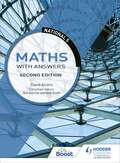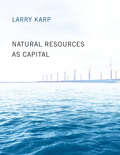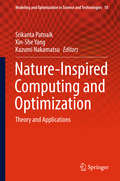- Table View
- List View
Modern Data Science with R (Chapman & Hall/CRC Texts in Statistical Science)
by Benjamin S. Baumer Daniel T. Kaplan Nicholas J. HortonModern Data Science with R is a comprehensive data science textbook for undergraduates that incorporates statistical and computational thinking to solve real-world problems with data. Rather than focus exclusively on case studies or programming syntax, this book illustrates how statistical programming in the state-of-the-art R/RStudio computing environment can be leveraged to extract meaningful information from a variety of data in the service of addressing compelling statistical questions. <P><P> Contemporary data science requires a tight integration of knowledge from statistics, computer science, mathematics, and a domain of application. This book will help readers with some background in statistics and modest prior experience with coding develop and practice the appropriate skills to tackle complex data science projects. The book features a number of exercises and has a flexible organization conducive to teaching a variety of semester courses.
Modern Real Analysis
by William P. ZiemerThis first year graduate text is a comprehensive resource in real analysis based on a modern treatment of measure and integration. Presented in a definitive and self-contained manner, it features a natural progression of concepts from simple to difficult. Several innovative topics are featured, including differentiation of measures, elements of Functional Analysis, the Riesz Representation Theorem, Schwartz distributions, the area formula, Sobolev functions and applications to harmonic functions. Together, the selection of topics forms a sound foundation in real analysis that is particularly suited to students going on to further study in partial differential equations. This second edition of Modern Real Analysis contains many substantial improvements, including the addition of problems for practicing techniques, and an entirely new section devoted to the relationship between Lebesgue and improper integrals. Aimed at graduate students with an understanding of advanced calculus, the text will also appeal to more experienced mathematicians as a useful reference.
Modern Statistics for the Social and Behavioral Sciences: A Practical Introduction (Second Edition)
by Rand Wilcox<p>Requiring no prior training, Modern Statistics for the Social and Behavioral Sciences provides a two-semester, graduate-level introduction to basic statistical techniques that takes into account recent advances and insights that are typically ignored in an introductory course. <p>Hundreds of journal articles make it clear that basic techniques, routinely taught and used, can perform poorly when dealing with skewed distributions, outliers, heteroscedasticity (unequal variances) and curvature. Methods for dealing with these concerns have been derived and can provide a deeper, more accurate and more nuanced understanding of data. A conceptual basis is provided for understanding when and why standard methods can have poor power and yield misleading measures of effect size. Modern techniques for dealing with known concerns are described and illustrated. <p>Features: <p> <li>Presents an in-depth description of both classic and modern methods <li>Explains and illustrates why recent advances can provide more power and a deeper understanding of data <li>Provides numerous illustrations using the software R <li>Includes an R package with over 1300 functions <li>Includes a solution manual giving detailed answers to all of the exercises</li> <p> <p>This second edition describes many recent advances relevant to basic techniques. For example, a vast array of new and improved methods is now available for dealing with regression, including substantially improved ANCOVA techniques. The coverage of multiple comparison procedures has been expanded and new ANOVA techniques are described.</p>
Molecular Data Analysis Using R
by Csaba Ortutay Zsuzsanna OrtutayThis book addresses the difficulties experienced by wet lab researchers with the statistical analysis of molecular biology related data. The authors explain how to use R and Bioconductor for the analysis of experimental data in the field of molecular biology. The content is based upon two university courses for bioinformatics and experimental biology students (Biological Data Analysis with R and High-throughput Data Analysis with R). The material is divided into chapters based upon the experimental methods used in the laboratories. Key features include:• Broad appeal--the authors target their material to researchers in several levels, ensuring that the basics are always covered.• First book to explain how to use R and Bioconductor for the analysis of several types of experimental data in the field of molecular biology.• Focuses on R and Bioconductor, which are widely used for data analysis. One great benefit of R and Bioconductor is that there is a vast user community and very active discussion in place, in addition to the practice of sharing codes. Further, R is the platform for implementing new analysis approaches, therefore novel methods are available early for R users.
Money Math: Addition and Subtraction
by David A. AdlerThis primer on money will change how you see addition and subtraction.What can a handful of coins get you? Well, it depends on how many you've got. . . . and what they are. In this fun introduction to American currency, a variety of past presidents introduce themselves and their denominations. You'll learn who's on each coin and bill, and what they're worth-- and how many of one it takes to add up to another. Dollars, cents, and decimals are explained in accessible, kid-friendly language, with tons of examples and try-it-yourself problems and activities. The mathematical concepts of addition, subtraction, multiplication and division become hands-on in this innovative math book from trusted duo David A. Adler and Edward Miller, whose award-winning collaborations have been helping students tackle complicated problems for years. After reading Money Math, kids will be confident with their pocket change!A Junior Library Guild Selection
Monte Carlo Methods for Radiation Transport
by Oleg N. VassilievThis book is a guide to the use of Monte Carlo techniques in radiation transport. This topic is of great interest for medical physicists. Praised as a "gold standard" for accurate radiotherapy dose calculations, Monte Carlo has stimulated a high level of research activity that has produced thousands of papers within the past few years. The book is designed primarily to address the needs of an academically inclined medical physicist who wishes to learn the technique, as well as experienced users of standard Monte Carlo codes who wish to gain insight into the underlying mathematics of Monte Carlo algorithms. The book focuses on the fundamentals--giving full attention to and explaining the very basic concepts. It also includes advanced topics and covers recent advances such as transport of charged particles in magnetic fields and the grid-based solvers of the Boltzmann equation.
Monte-Carlo Simulation-Based Statistical Modeling
by Ding-Geng Din Chen John Dean ChenThis book brings together expert researchers engaged in Monte-Carlo simulation-based statistical modeling, offering them a forum to present and discuss recent issues in methodological development as well as public health applications. It is divided into three parts, with the first providing an overview of Monte-Carlo techniques, the second focusing on missing data Monte-Carlo methods, and the third addressing Bayesian and general statistical modeling using Monte-Carlo simulations. The data and computer programs used here will also be made publicly available, allowing readers to replicate the model development and data analysis presented in each chapter, and to readily apply them in their own research. Featuring highly topical content, the book has the potential to impact model development and data analyses across a wide spectrum of fields, and to spark further research in this direction.
More Trouble with Maths: A Complete Manual to Identifying and Diagnosing Mathematical Difficulties (nasen spotlight)
by Steve ChinnMore Trouble with Maths acknowledges that there are many reasons why children and adults are unable to function mathematically. Difficulties include problems with rote learning basic facts and procedures, debilitating anxiety, poor working and short-term memories and mathematics vocabulary. Central to this new edition is a range of standardised tests and diagnostic activities, including a 15 minute test of basic mathematics, a thinking style test, tests of basic fact retrieval and maths anxiety. Guiding the reader in the interpretation of tests, this new edition shows how identifying the barriers to learning is the first step in a programme of intervention. Written in an engaging and user-friendly style, Steve Chinn draws on his extensive experience and expertise to: show how to consider and appraise the many factors relating to mathematical learning difficulties explain how these factors can be investigated explore their impact on learning mathematics. Emphasising the need for a clinical approach when assessing individuals, this book shows how diagnosis and assessment can become integrated into everyday teaching. This highly practical and relevant resource is a crucial resource for anyone who wants to accurately and effectively identify the depth and nature of mathematical learning difficulties and dyscalculia.
Mtel General Curriculum 03 Math Subtest & Multi Subject Study Guide Prep Book
by Mtel Curriculum Prep TeamEach section of the test has a comprehensive review created by Test Prep Books that goes into detail to cover all of the content likely to appear on the general curriculum MTEL test. The Test Prep Books MTEL general curriculum practice test questions are each followed by detailed answer explanations. If you miss a question, it’s important that you are able to understand the nature of your mistake and how to avoid making it again in the future. The answer explanations will help you to learn from your mistakes and overcome them. Understanding the latest test-taking strategies is essential to preparing you for what you will expect on the exam. A test taker has to not only understand the material that is being covered on the test, but also must be familiar with the strategies that are necessary to properly utilize the time provided and get through the test without making any avoidable errors. Test Prep Books has drilled down the top test-taking tips for you to know. Anyone planning to take this exam should take advantage of the MTEL review material, practice test questions, and test-taking strategies contained in this Test Prep Books study guide.
Multi-Agent Systems and Agreement Technologies
by Nardine Osman Natalia Criado Pacheco Carlos Carrascosa Vicente Julián IngladaThis book constitutes the revised selected papers from the 14th European Conference on Multi-Agent Systems, EUMAS 2016, and the Fourth International Conference on Agreement Technologies, AT 2016, held in Valencia, Spain, in December 2016. The 43 papers and 2 invited papers presented in this volume were carefully reviewed and selected from 68 submissions. The papers cover thematic areas as agent and multi-agent system models, algorithms, applications, simulations, theoretical studies, and for AT the thematic areas are: algorithms
Multi-Objective Optimization Problems
by Fran Sérgio Lobato Valder SteffenThis book is aimed at undergraduate and graduate students in applied mathematics or computer science, as a tool for solving real-world design problems. The present work covers fundamentals in multi-objective optimization and applications in mathematical and engineering system design using a new optimization strategy, namely the Self-Adaptive Multi-objective Optimization Differential Evolution (SA-MODE) algorithm. This strategy is proposed in order to reduce the number of evaluations of the objective function through dynamic update of canonical Differential Evolution parameters (population size, crossover probability and perturbation rate). The methodology is applied to solve mathematical functions considering test cases from the literature and various engineering systems design, such as cantilevered beam design, biochemical reactor, crystallization process, machine tool spindle design, rotary dryer design, among others.
Multi-State Survival Models for Interval-Censored Data (Chapman & Hall/CRC Monographs on Statistics and Applied Probability)
by Ardo van den HoutMulti-State Survival Models for Interval-Censored Data introduces methods to describe stochastic processes that consist of transitions between states over time. It is targeted at researchers in medical statistics, epidemiology, demography, and social statistics. One of the applications in the book is a three-state process for dementia and survival in the older population. This process is described by an illness-death model with a dementia-free state, a dementia state, and a dead state. Statistical modelling of a multi-state process can investigate potential associations between the risk of moving to the next state and variables such as age, gender, or education. A model can also be used to predict the multi-state process. The methods are for longitudinal data subject to interval censoring. Depending on the definition of a state, it is possible that the time of the transition into a state is not observed exactly. However, when longitudinal data are available the transition time may be known to lie in the time interval defined by two successive observations. Such an interval-censored observation scheme can be taken into account in the statistical inference. Multi-state modelling is an elegant combination of statistical inference and the theory of stochastic processes. Multi-State Survival Models for Interval-Censored Data shows that the statistical modelling is versatile and allows for a wide range of applications.
Multi-parametric Optimization and Control (Wiley Series in Operations Research and Management Science)
by Efstratios N. Pistikopoulos Nikolaos A. Diangelakis Richard OberdieckRecent developments in multi-parametric optimization and control Multi-Parametric Optimization and Control provides comprehensive coverage of recent methodological developments for optimal model-based control through parametric optimization. It also shares real-world research applications to support deeper understanding of the material. Researchers and practitioners can use the book as reference. It is also suitable as a primary or a supplementary textbook. Each chapter looks at the theories related to a topic along with a relevant case study. Topic complexity increases gradually as readers progress through the chapters. The first part of the book presents an overview of the state-of-the-art multi-parametric optimization theory and algorithms in multi-parametric programming. The second examines the connection between multi-parametric programming and model-predictive control—from the linear quadratic regulator over hybrid systems to periodic systems and robust control. The third part of the book addresses multi-parametric optimization in process systems engineering. A step-by-step procedure is introduced for embedding the programming within the system engineering, which leads the reader into the topic of the PAROC framework and software platform. PAROC is an integrated framework and platform for the optimization and advanced model-based control of process systems. Uses case studies to illustrate real-world applications for a better understanding of the concepts presented Covers the fundamentals of optimization and model predictive control Provides information on key topics, such as the basic sensitivity theorem, linear programming, quadratic programming, mixed-integer linear programming, optimal control of continuous systems, and multi-parametric optimal control An appendix summarizes the history of multi-parametric optimization algorithms. It also covers the use of the parametric optimization toolbox (POP), which is comprehensive software for efficiently solving multi-parametric programming problems.
Multilevel Modeling Using Mplus (Chapman & Hall/CRC Statistics in the Social and Behavioral Sciences)
by Holmes Finch Jocelyn BolinThis book is designed primarily for upper level undergraduate and graduate level students taking a course in multilevel modelling and/or statistical modelling with a large multilevel modelling component. The focus is on presenting the theory and practice of major multilevel modelling techniques in a variety of contexts, using Mplus as the software tool, and demonstrating the various functions available for these analyses in Mplus, which is widely used by researchers in various fields, including most of the social sciences. In particular, Mplus offers users a wide array of tools for latent variable modelling, including for multilevel data.
Multivariable Calculus with MATLAB®
by Ronald L. Lipsman Jonathan M. RosenbergThis comprehensive treatment of multivariable calculus focuses on the numerous tools that MATLAB#65533; brings to the subject, as it presents introductions to geometry, mathematical physics, and kinematics. Covering simple calculations with MATLAB#65533;, relevant plots, integration, and optimization, the numerous problem sets encourage practice with newly learned skills that cultivate the reader's understanding of the material. Significant examples illustrate each topic, and fundamental physical applications such as Kepler's Law, electromagnetism, fluid flow, and energy estimation are brought to prominent position. Perfect for use as a supplement to any standard multivariable calculus text, a "mathematical methods in physics or engineering" class, for independent study, or even as the class text in an "honors" multivariable calculus course, this textbook will appeal to mathematics, engineering, and physical science students. MATLAB#65533; is tightly integrated into every portion of this book, and its graphical capabilities are used to present vibrant pictures of curves and surfaces. Readers benefit from the deep connections made between mathematics and science while learning more about the intrinsic geometry of curves and surfaces. With serious yet elementary explanation of various numerical algorithms, this textbook enlivens the teaching of multivariable calculus and mathematical methods courses for scientists and engineers.
Multivariate Methods and Forecasting with IBM® SPSS® Statistics
by Abdulkader AljandaliThis is the second of a two-part guide to quantitative analysis using the IBM SPSS Statistics software package; this volume focuses on multivariate statistical methods and advanced forecasting techniques. More often than not, regression models involve more than one independent variable. For example, forecasting methods are commonly applied to aggregates such as inflation rates, unemployment, exchange rates, etc. , that have complex relationships with determining variables. This book introduces multivariate regression models and provides examples to help understand theory underpinning the model. The book presents the fundamentals of multivariate regression and then moves on to examine several related techniques that have application in business-orientated fields such as logistic and multinomial regression. Forecasting tools such as the Box-Jenkins approach to time series modeling are introduced, as well as exponential smoothing and na#65533;ve techniques. This part also covers hot topics such as Factor Analysis, Discriminant Analysis and Multidimensional Scaling (MDS).
Multivariate Modelling of Non-Stationary Economic Time Series
by John Hunter Simon P. Burke Alessandra CanepaThis book examines conventional time series in the context of stationary data prior to a discussion of cointegration, with a focus on multivariate models. The authors provide a detailed and extensive study of impulse responses and forecasting in the stationary and non-stationary context, considering small sample correction, volatility and the impact of different orders of integration. Models with expectations are considered along with alternate methods such as Singular Spectrum Analysis (SSA), the Kalman Filter and Structural Time Series, all in relation to cointegration. Using single equations methods to develop topics, and as examples of the notion of cointegration, Burke, Hunter, and Canepa provide direction and guidance to the now vast literature facing students and graduate economists.
Music Data Analysis: Foundations and Applications (Chapman & Hall/CRC Computer Science & Data Analysis)
by Claus Weihs, Dietmar Jannach, Igor Vatolkin and Günter RudolphThis book provides a comprehensive overview of music data analysis, from introductory material to advanced concepts. It covers various applications including transcription and segmentation as well as chord and harmony, instrument and tempo recognition. It also discusses the implementation aspects of music data analysis such as architecture, user interface and hardware. It is ideal for use in university classes with an interest in music data analysis. It also could be used in computer science and statistics as well as musicology.
Nabokov's Favorite Word Is Mauve: What the Numbers Reveal About the Classics, Bestsellers, and Our Own Writing
by Ben BlattWhat are our favorite authors’ favorite words? Which bestselling writer uses the most clichés? How can we judge a book by its cover? Data meets literature in this playful and informative look at our favorite authors and their masterpieces. “A literary detective story: fast-paced, thought-provoking, and intriguing.” —Brian Christian, coauthor of Algorithms to Live ByThere’s a famous piece of writing advice—offered by Ernest Hemingway, Stephen King, and myriad writers in between—not to use -ly adverbs like “quickly” or “fitfully.” It sounds like solid advice, but can we actually test it? If we were to count all the -ly adverbs these authors used in their careers, do they follow their own advice compared to other celebrated authors? What’s more, do great books in general—the classics and the bestsellers—share this trait? In Nabokov’s Favorite Word Is Mauve, statistician and journalist Ben Blatt brings big data to the literary canon, exploring the wealth of fun findings that remain hidden in the works of the world’s greatest writers. He assembles a database of thousands of books and hundreds of millions of words, and starts asking the questions that have intrigued curious word nerds and book lovers for generations: What are our favorite authors’ favorite words? Do men and women write differently? Are bestsellers getting dumber over time? Which bestselling writer uses the most clichés? What makes a great opening sentence? How can we judge a book by its cover? And which writerly advice is worth following or ignoring? Blatt draws upon existing analysis techniques and invents some of his own. All of his investigations and experiments are original, conducted himself, and no math knowledge is needed to understand the results. Blatt breaks his findings down into lucid, humorous language and clear and compelling visuals. This eye-opening book will provide you with a new appreciation for your favorite authors and a fresh perspective on your own writing, illuminating both the patterns that hold great prose together and the brilliant flourishes that make it unforgettable.
Naive Set Theory (Dover Books on Mathematics)
by Paul R. HalmosThis classic by one of the twentieth century's most prominent mathematicians offers a concise introduction to set theory. Suitable for advanced undergraduates and graduate students in mathematics, it employs the language and notation of informal mathematics. There are very few displayed theorems; most of the facts are stated in simple terms, followed by a sketch of the proof. Only a few exercises are designated as such since the book itself is an ongoing series of exercises with hints. The treatment covers the basic concepts of set theory, cardinal numbers, transfinite methods, and a good deal more in 25 brief chapters.
Nanoscale AFM and TEM Observations of Elementary Dislocation Mechanisms
by Jozef VeselýThis thesis addresses elementary dislocation processes occurring in single-crystalline alloys based on Fe-Al, and investigates correspondences between dislocation distribution inside crystals characterized by transmission electron microscopy (TEM) and surface patterns observed using atomic force microscopy (AFM). Fe-Al alloys with different degrees of ordering were prepared and deformed in compression at ambient temperature in-situ inside the AFM device. The evolution of slip line structures was captured in the sequences of AFM images and wavy slip bands, while cross slip at the tip of the slip band and homogeneous fine slip lines were also identified. Further, the thesis develops a technique for constructing 3D representations of dislocations observed by TEM without the prohibitive difficulties of tomography, and creates 3D models of dislocation structures. Generally speaking, the thesis finds good agreement between AFM and TEM observations, confirming the value of AFM as a relevant tool for studying dislocations.
National 5 Maths with Answers, Second Edition
by David AlcornExam Board: SQALevel: National 5Subject: MathematicsFirst Teaching: September 2017First Exam: Summer 2018National 5 Maths Second Edition offers updated, rearranged and complete coverage of the SQA syllabus for the examination of the same name from 2017/18 onwards. - Provides thorough preparation for the exam, as revised for the updated syllabus.- Covers all the topics necessary for the revised examination.- Offers a suggested approach through all five sections (Number, Algebra, Geometry, Trigonometry and Statistics), flexibly structured so that teachers and students are also free to select alternative routes to suit individual needs.- Organised content makes it easy to plan, manage and monitor progress.- Each chapter consists of:>Worked Examples with explanatory notes showing how skills are applied >Practice Exercises that are graded to build confidence >Key Points that summarise key points and skills>Review Exercise that provides the opportunity to consolidate topics introduced in the chapter- Includes Revision Exercises, for non-calculator and calculator papers, provide opportunities to consolidate skills acquired during the course.- Exam Practice provides further questions in preparation for the extended examination(s) of the revised syllabus.
Natural Resources as Capital (The\mit Press Ser.)
by Larry KarpAn introduction to the concepts and tools of natural resource economics, including dynamic models, market failures, and institutional remedies.This introduction to natural resource economics treats resources as a type of capital; their management is an investment problem requiring forward-looking behavior within a dynamic setting. Market failures are widespread, often associated with incomplete or nonexistent property rights, complicated by policy failures. The book covers standard resource economics topics, including both the Hotelling model for nonrenewable resources and models for renewable resources. The book also includes some topics in environmental economics that overlap with natural resource economics, including climate change.The text emphasizes skills and intuition needed to think about dynamic models and institutional remedies in the presence of both market and policy failures. It presents the nuts and bolts of resource economics as applied to nonrenewable resources, including the two-period model, stock-dependent costs, and resource scarcity. The chapters on renewable resources cover such topics as property rights as an alternative to regulation, the growth function, steady states, and maximum sustainable yield, using fisheries as a concrete setting. Other, less standard, topics covered include microeconomic issues such as arbitrage and the use of discounting; policy problems including the “Green Paradox”; foundations for policy analysis when market failures are important; and taxation. Appendixes offer reviews of the relevant mathematics. The book is suitable for use by upper-level undergraduates or, with the appendixes, masters-level courses.
Nature-Inspired Computing and Optimization
by Xin-She Yang Srikanta Patnaik Kazumi NakamatsuThe book provides readers with a snapshot of the state of the art in the field of nature-inspired computing and its application in optimization. The approach is mainly practice-oriented: each bio-inspired technique or algorithm is introduced together with one of its possible applications. Applications cover a wide range of real-world optimization problems: from feature selection and image enhancement to scheduling and dynamic resource management, from wireless sensor networks and wiring network diagnosis to sports training planning and gene expression, from topology control and morphological filters to nutritional meal design and antenna array design. There are a few theoretical chapters comparing different existing techniques, exploring the advantages of nature-inspired computing over other methods, and investigating the mixing time of genetic algorithms. The book also introduces a wide range of algorithms, including the ant colony optimization, the bat algorithm, genetic algorithms, the collision-based optimization algorithm, the flower pollination algorithm, multi-agent systems and particle swarm optimization. This timely book is intended as a practice-oriented reference guide for students, researchers and professionals.
